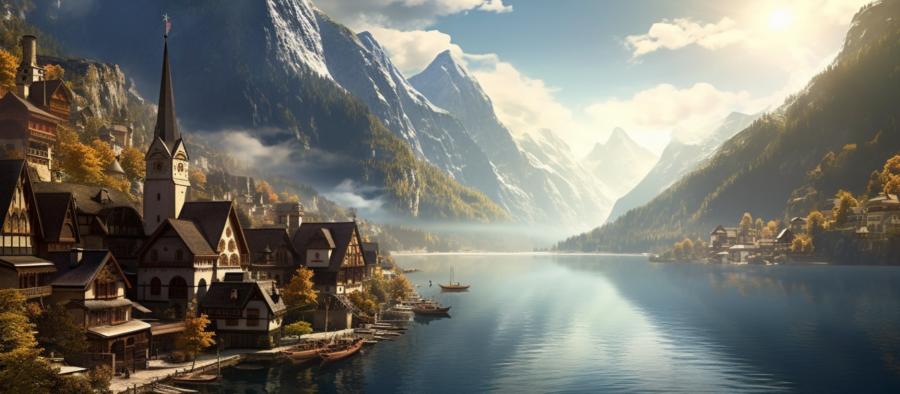Unmasking the Allure of Austria's Hallstatt

A Tale of Two Hallstatts
As I meandered through the idyllic village of Hallstatt, nestled between the glassy Lake Hallstatt and the towering Dachstein Mountains, I couldn't help but marvel at its uncanny resemblance to its doppelgänger in China. You see, the Chinese were so smitten with this Austrian hamlet that they replicated it brick by brick in their own Guangdong Province. I must admit, both the original and its clone possess a certain je ne sais quoi that draws one in with their picturesque landscapes and quaint architecture. Yet, the Hallstatt I sauntered through had an air of authenticity that its Far Eastern counterpart could never quite capture.Enter the Salt Mines of Hallstatt
What is it that makes this village so enchanting? It may be the age-old ties to the salt mining industry that have shaped its history and granted it a UNESCO World Heritage title. I couldn't resist the urge to delve into the subterranean world of the Salzwelten Hallstatt, the world's oldest salt mine. As I donned the traditional white miners" overalls, I felt as though I was about to embark on a journey through time, following in the footsteps of generations of miners who toiled in these caverns over 7,000 years ago.Descending into the depths of the mine, I encountered an unexpected sight: the mummified remains of a prehistoric miner, who had been entombed in the salt for millennia. Imagine my delight, realizing that this chap had the unique privilege of being preserved like a culinary delight in his own workplace! I continued to weave my way through the labyrinth of tunnels, past the subterranean salt lake and the gigantic slides that once whisked miners swiftly between levels. This otherworldly experience left me with a profound appreciation for the salt that I liberally sprinkle on my fish and chips.
A Romp in the Hallstatt Bone House
On a lighter note, I stumbled upon a peculiar little building nestled behind the iconic St. Michael's Chapel. This was none other than the Hallstatt Beinhaus, or Bone House, home to over 1,200 skulls dating back to the 18th century. I, for one, have never seen such an impressive collection of craniums outside of my own fevered nightmares. I wondered how this macabre menagerie came to be, and soon discovered that it was a byproduct of the village's limited burial space.As the dearly departed were laid to rest, their graves had expiration dates; once their time was up, the bones were exhumed, bleached by the sun, and finally decorated with intricate designs. I couldn't help but admire the artistry and care taken in honoring the dead, as I gazed upon the rows of skulls bearing the names and dates of their former owners. This surreal shrine to mortality left me pondering my own inevitable return to dust. Or perhaps, should I choose to make Hallstatt my final resting place, an intricately adorned skull on a shelf.
Wooden Treasures of the UNESCO-Listed Market Square
Shaking off my existential musings, I wandered into the heart of the village - the UNESCO-listed Market Square. Here, I was greeted by an array of charming wooden buildings adorned with intricate carvings and colorful flower boxes. I felt as though I had stepped into a fairy tale, half expecting to see a gingerbread house tucked amid the timbered facades.At the center of the square stands the imposing Trinity Column, a stone monument that seems to defy gravity as it stretches skywards. I couldn't help but notice the abundance of frogs adorning various surfaces of the square, paying homage to the ancient belief that these amphibious creatures bring good fortune. I contemplated pocketing one of the tiny wooden frog souvenirs, but thought better of it - who am I to disrupt the delicate balance of luck in this magical place?
Final Thoughts on Austria's Hallstatt
As the sun dipped below the horizon, casting a warm golden glow over the village, I bid farewell to Hallstatt and its beguiling blend of natural beauty and human history. It is a place where time seems to stand still, and where the whispers of the past echo through the narrow streets and ancient mine tunnels. I departed with a newfound appreciation for salt, a lingering fascination with skulls, and a pocketful of wooden frogs - because one can never have too much good luck.Article kindly provided by myfavouritehols.com
Latest Articles
- How to Plan Around Peak Congestion Days for Mountain Trips
- Mapping Your First Mountain Resort Loop Without Losing Your Sanity
- How Pro Kitchen Renovations Quietly Increase Booking Confidence in Self-Catering Stays
- Discover a City's Real Character From the Backseat
- How to Make Airport Layovers Surprisingly Productive
- From HVAC to ROI: the Hidden Economics of Sustainable Hotel Design
- How to Plan Your Day Tours to Minimize Crowds and Maximize Serendipity
- From Tourist to Observer: How to Photograph a City Like a Local
- Seasonal Shifts in Abandoned Turkish Valleys Reveal Clues About Heritage Site Decay
- Mastering Group Travel Planning for Events in Fort Lauderdale
- Beyond the Beach Bus: Hidden Palm Beach Spots Worth the Group Ride
- Chrono-Travel and Time Zone Acrobatics on a Coach
- Hidden Miami Charter Bus Routes to Secret Beaches, Local Food Gems, and Underrated Attractions
- More Than Just Ice - Unexpected Events at Amerant Bank Arena
- Madrid's Strangest Museums and Attractions You Never Knew Existed
- Disaster-Proof Rentals: A Flood-Resilient Guide for Holiday Homeowners
- Following the Footsteps of Filmmakers: Morocco's Iconic Movie Locations You Can Visit
- Hidden Gems Along Morocco's Coastline
- Tastes of Miami: Culinary Tours for the Global Foodie
- Milwaukee's Hidden Green Gems: Nature's Best Kept Secrets

